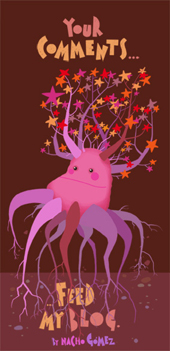
Judith Schaechter, Stained Glass, Snakes and Ladders 31"X30", 2003
The first time I ever saw Judith Schaechter's work I was doing our yearly NYC Chelsea gallery walk with our senior high-school class and it was quite a few years ago. I was floored by a stained glass artist using the medium in such a fresh/new, illustrative way. To me, she is the first artist that has therefore given a medium that I felt had been relegated to sun catchers, imitation Tiffany lamps, craft fairs and cathedral metaphors of 'enlightenment' a new face. Not everyone may appreciate Judith's work since it has a macabre, sombre often deathly glow about it. She enjoys investigating "...sex and death, with romance and violence the obvious runners up. I'm trying to be as cliche, sentimental, and decorative as possible--not as a strategy for ironic commentary about how stupid sentimentality and clichés are, but because this is the stuff, that time and time again, I am obsessed with, in love with, and that I have faith in."- Judith Schaecter
Grant it my husband and I, appreciate this kind of sensibility. We are after all huge Tim Burton fans! We each are collectors of Nightmare Before Christmas memorabilia before we met...he had all the Jack stuff and I had all the Sally. In fact, my husband's cousin Facundo Rabaudi worked as a model-maker on the set of that film (along with quite a few other phenomenal animations), and we were able to see some of the actual pieces used in Nightmare in real life! We love Edward Scissorhands, Corpse Bride, and Tim Burton's book of poetry - The Melancholy Death of Oyster Boy...so you see Judith Schaechter's work doesn't jar us in any negative way.
Technically, Judith's art is brilliant and painstaking work. She uses something called flash glass, a material that I am still looking into which she sand-blasts, etches and layers to get the color. I am still researching the areas that look so painterly.
My understanding is that Judth Schaecter uses the copper foil method, as do I. If this is true, it makes me happy to hear since I haven't had the opportunity to learn the lead came method and I always berate myself for it. So yes, I enjoy stained glass too. Here is a sample of one of my older stained glass pieces of a Phoenix.

My work pales in comparison to Judith Schaecter, but I am looking forward to the inspiration she serves me and my newest adventures in drawing on glass with powdered frit. Right now though I'm working on a series of oil paintings for the Herstory project and it will be while before I get to play with stained glass again.
Whether you work in glass, are a writer, illustrator or painter, seeing the work of other artists can inform your own discipline in countless ways. So check out new artists working around you and get inspired!
 Tuesday, September 2, 2008 at 10:38PM
Tuesday, September 2, 2008 at 10:38PM  Forgive Them Father For They Know Not What They Do by marisol diaz
Forgive Them Father For They Know Not What They Do by marisol diaz Art,
Art,  Glass,
Glass,  Illustration
Illustration 






















 Stumble It!
Stumble It!












